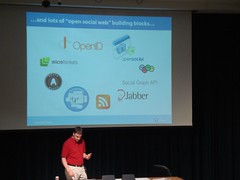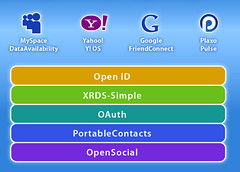Performance Challenges for the Open Web
Stanford CS193H: High Performance Web Sites
Stanford, CA
September 29, 2008
Download PPT (6.8 MB)
 Web site performance guru Steve Souders is teaching a class at Stanford this fall on High Performance Web Sites (CS193H). He invited me to give a guest lecture to his class on the new performance challenges emerging from our work to open up the social web. As a recent Stanford alum (SSP ’02, co-term ’03), it was a thrill to get to teach a class at my alma mater, esp. in the basement of the Gates bldg, where I’ve taken many classes myself.
Web site performance guru Steve Souders is teaching a class at Stanford this fall on High Performance Web Sites (CS193H). He invited me to give a guest lecture to his class on the new performance challenges emerging from our work to open up the social web. As a recent Stanford alum (SSP ’02, co-term ’03), it was a thrill to get to teach a class at my alma mater, esp. in the basement of the Gates bldg, where I’ve taken many classes myself.
I originally met Steve at OSCON 07 when I was working on high-performance JavaScript, and we were giving back-to-back talks. We immediately hit it off and have remained in good touch since. Over the last year or so, however, my focus has shifted to opening up the social web. So when Steve asked me to speak at his class, my first reaction was “I’m not sure I could tell your students anything new that isn’t already in your book”.
But upon reflection, I realized that a lot of the key challenges in creating a truly social web are directly related to performance, and the set of performance challenges in this space are quite different than in optimizing a single web site. In essence, the challenge is getting multiple sites to work together and share content in a way that’s open and flexible but also tightly integrated and high-performance. Thus my new talk was born.
 I provided the students with an overview of the emerging social web ecosystem, and some of the key open building blocks making it possible (OpenID, OAuth, OpenSocial, XRDS-Simple, microformats, etc.). I then gave some concrete examples of how these building blocks can play together, and that led naturally into a discussion of the performance challenges involved.
I provided the students with an overview of the emerging social web ecosystem, and some of the key open building blocks making it possible (OpenID, OAuth, OpenSocial, XRDS-Simple, microformats, etc.). I then gave some concrete examples of how these building blocks can play together, and that led naturally into a discussion of the performance challenges involved.
I broke the challenges into four primary categories:
- minimizing round trips (the challenge is combining steps to optimize vs. keeping the pieces flexible and simple),
- caching (storing copies of user data for efficiency vs. always having a fresh copy),
- pull vs. push (the difficulty of scaling mass-polling and the opportunities presented by XMPP and Gnip to decrease both latency and load), and
- integrating third-party content (proxying vs. client-side fetching, iframes vs. inline integration, etc.).
In each of these cases, there are fundamental trade-offs to make, so there’s no “easy, right answer”. But by understanding the issues involved, you can make trade-offs that are tailored to the situation at hand. Some of the students in that class will probably be writing the next generation of social apps, so I’m glad they can start thinking about these important issues today.



